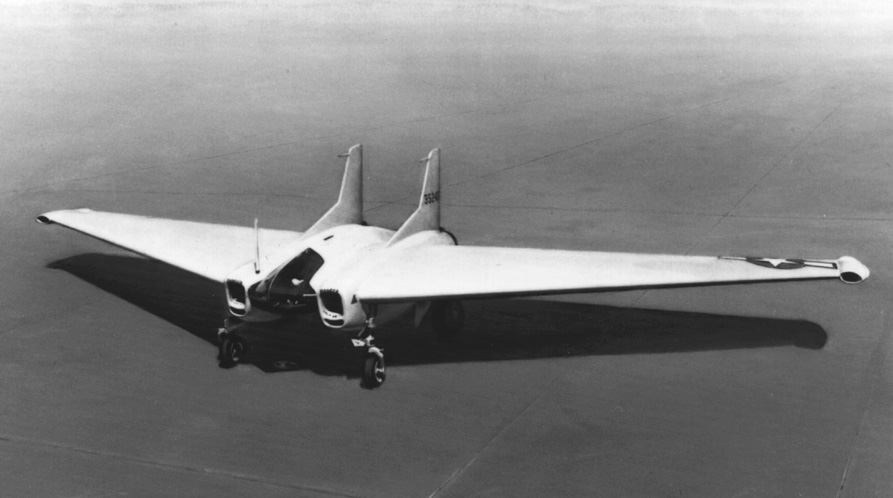W.I.N.T.E.R. I hate to bust your bubble, but Germany did NOT have a lock on silly and stupid ideas.

Here is a Blurb about the XP-79 from the history. net site. And as you can see, unlike the MODIFIED Fw-190's the Luftwaffe flew, the Northrop plane was DESIGNED from the outset as a rammer.

In the late stages of World War II, American bomber formations over Germany were occasionally attacked by a small, rocket-powered interceptor, the Messerschmitt Me-163 Komet. Fast as the Me-163s were, however, they were usually more spectacular than effective. Nevertheless, American aircrews must have marveled at the technology behind such an advanced-looking weapon--unaware that since 1942, something similar had been secretly under development in their own country.
The fighter that eventually became the Northrop XP-79B had an astonishing parallel development to the Me-163. It began in 1942 as a rocket-powered flying wing, but, in contrast to the Me-163, the American design was later adapted for jet power. Another difference between the XP-79B and its distant German cousin lay in their methods of attack. The Me-163 was meant to defend a faltering Third Reich with wing-mounted 30mm cannons or unguided rockets. The XP-79B's main means of downing its adversaries is best expressed in its nickname--Flying Ram.
Essentially, the XP-79 was an interceptor that would bring down its opponents by ramming them in flight. During the early months of the German invasion of Russia in 1941 and 1942, Russian fighter pilots had frequently resorted to various taran, or midair ramming techniques. There was no real need for American fighter pilots to resort to such tactics, however, and the USAAF officer who came up with the idea for the ram fighter may be grateful that his identity is lost to history. In any case, in January 1943, Northrop was awarded a contract to build three XP-79 Flying Ram prototypes, each of which was to be powered by an Aerojet rocket engine with 2,000 pounds of thrust.
A plague of developmental problems with the proposed Aerojet engine, and the unlikelihood of its being able to keep the plane airborne for more than 30 minutes, led the USAAF to cancel its order for the rockets and for two of the XP-79s that were to be powered by them. The Army did, however, consent to completion of the third prototype, which used two Westinghouse 19B axial-flow jet engines with 1,345 pounds of thrust each. The jet-engine revision, designated the XP-79B, weighed 5,840 pounds empty and 8,669 pounds with a full operational load.
Like its rocket-powered precursor, the jet-powered XP-79B was essentially a wing, with the pilot lying on his stomach between the two jet engines. His head protruded into an acrylic-plastic windshield fitted with an armor glass section. An overhead hatch gave him entry to and, if necessary, a hasty exit from the cabin.
As radical as the XP-79's all-wing configuration looked, its structure was equally unusual. The airframe was made of heavy-gauge magnesium. The leading-edge skin was three-fourths of an inch thick; reinforcing steel armor plate of one-fourth-inch thickness was heliarc-welded at a 45-degree angle just inside the wing's leading edge. The wingspan was 38 feet, with a wing area of 278 square feet. Overall, the XP-79 was 14 feet long and 7 feet high.
Upon receiving reports of approaching enemy bombers, the XP-79B was intended to take off with the aid of JATO (jet-assisted takeoff) packs at an estimated rate of 25,000 feet in 4.7 minutes. Reaching an altitude of 40,000 feet, the Flying Ram would then dive into the formation of enemy aircraft at an estimated speed of up to 547 mph and clip their wing or tail surfaces with its own reinforced wings. Even among the USAAF brass, someone must have recognized the need for weapons, because the XP-79B order also stipulated that the fighter should accommodate four .50-caliber Browning machine guns outboard of the jet engines.
So as you can see I was correct when I told Roman Legion of an aircraft that was DESIGNED, not modified for ramming.



Cheers, Thorgrimm

Cheers, Thorgrimm



Cheers, Thorgrimm






